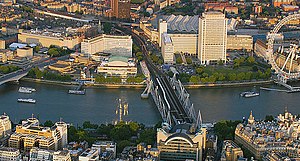為什麼英國人對馬肉如此敏感?
報道 2013年02月27日

Johannes Cleris/European Pressphoto Agency
瑞典的一幅宜家廣告海報。
倫敦——英國人通常可以藉助莎士比亞,為當前的困境找到相應的文學描寫。但是很奇怪,英國人有句耳熟能詳的台詞,用在今天卻偏偏很不恰當。
1485年,在博斯沃斯平原的戰場上,即將戰敗的理查三世(Richard III)喊道,“一匹馬,一匹馬,我的王國換一匹馬!”但現在,似乎英國人最不想要的就是馬,至少不想在標明了是別的肉類的食品裡面吃出馬肉。
幾周來,英國密切關注一場波及全歐洲的醜聞:一些家喻戶曉的品牌出售的肉類加工品,包裝上寫着純牛肉,卻檢測出了馬的DNA。這些食品中包括波隆那
意大利麵、千層面和漢堡包。電視紀錄片對此展開了調查,報紙頭條大肆宣揚此事,博客作者為此撰文,Twitter用戶紛紛轉發這條消息。
但似乎無人能夠解釋清楚,為何食物中出現一點點馬肉,英國的消費者和食客就如此擔憂,而他們的鄰居,法國、荷蘭等其他歐洲國家民眾都能心平氣和地吃馬肉呢?
善於反思的英國人挖掘了一系列原因。例如,根據英國古老的禁忌,不可食用被人類視為寵物、夥伴、及體育和戰爭英雄的動物。又例如,此事是諸多欺騙公眾行為的又一個案例。
亞歷山大·路西·史密斯(Alexander Lucie-Smith)牧師在《天主教先驅報》(The Catholic Herald)上撰文稱,“這不是馬肉醜聞,這是商品標籤醜聞”,此事令人質疑,“我們還能相信商品標籤上的任何信息嗎?”
近期的瘋牛病和口蹄疫動搖了人們對英國畜群的信心。對這兩種疫病的記憶,可以部分地回答這個問題。一項學術研究甚至將厭食馬肉的傳統追溯到八世紀。當時,教皇格里高利三世(Pope Gregory III)試圖迫使新皈依的盎格魯-撒克遜人擯棄吃馬肉這種異教習俗。
此番的喧囂也反映了一些消費者的不安。他們認為自己遭受了雙重愚弄。由於經濟緊縮,他們被迫購買便宜的成品食物。然而,出售這些食品的連鎖企業,卻 又被那些追求暴富、偷偷摸摸的供應商,甚至是犯罪團伙操縱。而且,該醜聞也令人想起英國根深蒂固的等級差異。富人買得起屠戶手中昂貴的鮮切肉。他們嘲笑買 不起鮮肉的大眾。
馬肉比牛肉便宜得多。而且,調查還發現了一條缺乏監管的地下產業鏈,一直延伸到羅馬尼亞和墨西哥,根本不知道是在哪個環節把馬肉混入了牛肉製品,英國人悠久的喜愛牛肉的傳統被利用了。
早在15世紀,法國騎兵統帥就這樣分析英國人:“給他們一頓牛肉大餐和鋼鐵,他們就會像狼一樣大吃,像魔鬼一樣戰鬥。”是的,這句話也出自莎士比亞,這次是《亨利五世》(Henry V)。
法國人戲稱英國人為“燒牛肉”(les rosbifs),這不是沒有道理的,這也表現出法國人對英國飲食完全嗤之以鼻的態度。
據說,法國人是在1807年埃勞戰役(Battle of Eylau)中為自己的飲食習慣找到了依據。這有可能只是傳說,但據說當時拿破崙大軍的軍醫長巴龍·多米尼克-讓·拉雷(Baron Dominique-Jean Larrey)下令飢餓的士兵吃戰死的馬肉,讓愛吃馬肉成了法國人的神聖傳統。
直到今天,在巴黎一個我經常去的地方,一家賣馬肉的屠戶還在一周兩次的街邊集市上驕傲地擺攤營業,她旁邊有賣海鮮、熟布里奶酪、烤雞、鵝肝醬還有用剁碎的豬腸做餡的法國香腸的攤位。用豬下水做香腸,這對一些人來說恐怕就像馬肉對英國人一樣地奇怪。
換句話說,飲食決定了身份。就像德國教授維克托·B·邁爾-羅霍(Victor B. Meyer-Rochow)在自由歐洲電台(Radio Free Europe)上說的那樣,“我們說馬是這樣一種高貴的動物,所以不能吃馬肉,這樣,我們就抬高了自己,讓我們顯得比那些吃馬肉像吃兔肉一樣的人要優越。”
然而,這件事還傳遞出一個更加灰暗的信息。最近年,關於英國媒體、BBC、國家醫療服務體系(National Health Service)、議會以及政客個人的醜聞不斷被曝光。操控基準利率和不當銷售金融工具的醜聞曝光更是加劇了2008年金融危機以來人們對銀行和銀行家的 信任危機。
的確,《獨立報》(The Independent)前任編輯安德烈亞斯·惠特曼·史密斯(Andreas Whittam Smith)曾在該報上稱,“越深入地審視馬肉醜聞,就越讓人聯想到銀行業危機的根源”——掛着牛頭賣馬肉,不正像打着安全投資的幌子,推銷次級抵押貸款 一樣嗎?
或許,真正顯示了英國人特點的,是一連串與馬有關的冷笑話,說明英國人面對又一次的欺詐行為,還是只能由它去,詐騙得不到解釋,也得不到懲罰,普通人基本沒有選擇,只能阿Q式地自我寬慰,想想那句老話:商品售出,概不負責,買方留心。
其中一個比較好玩的笑話是這樣的:一個漢堡包走進酒吧點杯喝的。侍者說,“我聽不清楚。”漢堡包回答道,“對不起,我嗓子有點啞。”(英文“沙啞”[hoarse]與“馬”同音——譯註)
1485年,在博斯沃斯平原的戰場上,即將戰敗的理查三世(Richard III)喊道,“一匹馬,一匹馬,我的王國換一匹馬!”但現在,似乎英國人最不想要的就是馬,至少不想在標明了是別的肉類的食品裡面吃出馬肉。
但似乎無人能夠解釋清楚,為何食物中出現一點點馬肉,英國的消費者和食客就如此擔憂,而他們的鄰居,法國、荷蘭等其他歐洲國家民眾都能心平氣和地吃馬肉呢?
善於反思的英國人挖掘了一系列原因。例如,根據英國古老的禁忌,不可食用被人類視為寵物、夥伴、及體育和戰爭英雄的動物。又例如,此事是諸多欺騙公眾行為的又一個案例。
亞歷山大·路西·史密斯(Alexander Lucie-Smith)牧師在《天主教先驅報》(The Catholic Herald)上撰文稱,“這不是馬肉醜聞,這是商品標籤醜聞”,此事令人質疑,“我們還能相信商品標籤上的任何信息嗎?”
近期的瘋牛病和口蹄疫動搖了人們對英國畜群的信心。對這兩種疫病的記憶,可以部分地回答這個問題。一項學術研究甚至將厭食馬肉的傳統追溯到八世紀。當時,教皇格里高利三世(Pope Gregory III)試圖迫使新皈依的盎格魯-撒克遜人擯棄吃馬肉這種異教習俗。
此番的喧囂也反映了一些消費者的不安。他們認為自己遭受了雙重愚弄。由於經濟緊縮,他們被迫購買便宜的成品食物。然而,出售這些食品的連鎖企業,卻 又被那些追求暴富、偷偷摸摸的供應商,甚至是犯罪團伙操縱。而且,該醜聞也令人想起英國根深蒂固的等級差異。富人買得起屠戶手中昂貴的鮮切肉。他們嘲笑買 不起鮮肉的大眾。
馬肉比牛肉便宜得多。而且,調查還發現了一條缺乏監管的地下產業鏈,一直延伸到羅馬尼亞和墨西哥,根本不知道是在哪個環節把馬肉混入了牛肉製品,英國人悠久的喜愛牛肉的傳統被利用了。
早在15世紀,法國騎兵統帥就這樣分析英國人:“給他們一頓牛肉大餐和鋼鐵,他們就會像狼一樣大吃,像魔鬼一樣戰鬥。”是的,這句話也出自莎士比亞,這次是《亨利五世》(Henry V)。
法國人戲稱英國人為“燒牛肉”(les rosbifs),這不是沒有道理的,這也表現出法國人對英國飲食完全嗤之以鼻的態度。
據說,法國人是在1807年埃勞戰役(Battle of Eylau)中為自己的飲食習慣找到了依據。這有可能只是傳說,但據說當時拿破崙大軍的軍醫長巴龍·多米尼克-讓·拉雷(Baron Dominique-Jean Larrey)下令飢餓的士兵吃戰死的馬肉,讓愛吃馬肉成了法國人的神聖傳統。
直到今天,在巴黎一個我經常去的地方,一家賣馬肉的屠戶還在一周兩次的街邊集市上驕傲地擺攤營業,她旁邊有賣海鮮、熟布里奶酪、烤雞、鵝肝醬還有用剁碎的豬腸做餡的法國香腸的攤位。用豬下水做香腸,這對一些人來說恐怕就像馬肉對英國人一樣地奇怪。
換句話說,飲食決定了身份。就像德國教授維克托·B·邁爾-羅霍(Victor B. Meyer-Rochow)在自由歐洲電台(Radio Free Europe)上說的那樣,“我們說馬是這樣一種高貴的動物,所以不能吃馬肉,這樣,我們就抬高了自己,讓我們顯得比那些吃馬肉像吃兔肉一樣的人要優越。”
然而,這件事還傳遞出一個更加灰暗的信息。最近年,關於英國媒體、BBC、國家醫療服務體系(National Health Service)、議會以及政客個人的醜聞不斷被曝光。操控基準利率和不當銷售金融工具的醜聞曝光更是加劇了2008年金融危機以來人們對銀行和銀行家的 信任危機。
的確,《獨立報》(The Independent)前任編輯安德烈亞斯·惠特曼·史密斯(Andreas Whittam Smith)曾在該報上稱,“越深入地審視馬肉醜聞,就越讓人聯想到銀行業危機的根源”——掛着牛頭賣馬肉,不正像打着安全投資的幌子,推銷次級抵押貸款 一樣嗎?
或許,真正顯示了英國人特點的,是一連串與馬有關的冷笑話,說明英國人面對又一次的欺詐行為,還是只能由它去,詐騙得不到解釋,也得不到懲罰,普通人基本沒有選擇,只能阿Q式地自我寬慰,想想那句老話:商品售出,概不負責,買方留心。
其中一個比較好玩的笑話是這樣的:一個漢堡包走進酒吧點杯喝的。侍者說,“我聽不清楚。”漢堡包回答道,“對不起,我嗓子有點啞。”(英文“沙啞”[hoarse]與“馬”同音——譯註)













